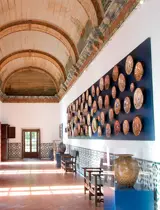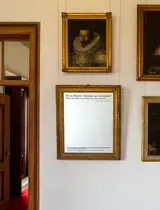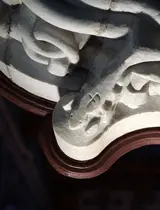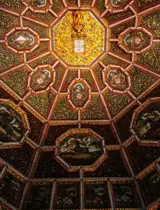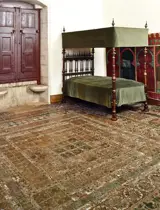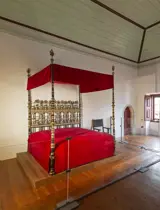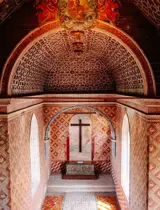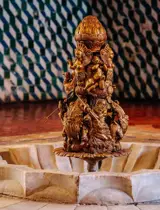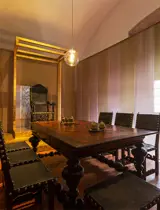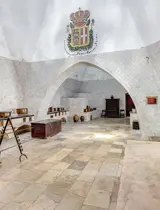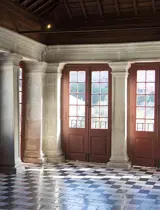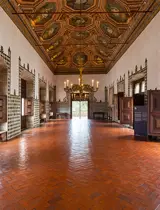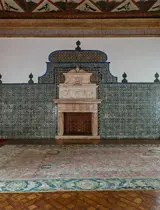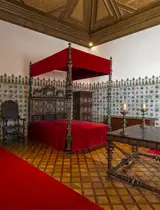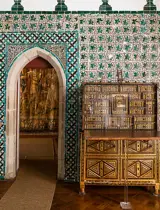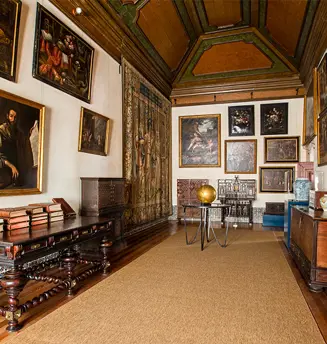
Camarim
Camarim
In the 15th century, this room was divided into three small, more private compartments that could be used as an annex to the Wardrobe.
It is thought that the partition walls were demolished in the 18th century when its name was changed to the Camarim.
The Camarim, like the Wardrobe, was used to store objects of great splendour.
Discover the objects on display in this room.
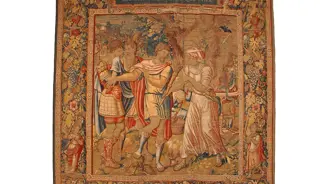
Tapestry “Caesar and Spurina”
- Brussels, 1560-1570
- Wool and silk
- Inv. No. PNS3573
The seer Spurina warns the Roman emperor Julius Caesar to beware of the Ides of March, the date on which he would be assassinated. It belongs to a series entitled the "History of the Life and Deeds of Julius Caesar" and was brought to the Palace in 1939.
Tapestries were the most sumptuous and expensive objects in a noble house. Episodes of classical history or mythology provided opportunities to learn from the past.

Celestial Globe
- Christoph Schissler
- Augsburg, Germany, 1575
- Gilded metal and iron
- Inv. No. PNS3457
This globe represents the celestial sphere, with constellations and signs of the zodiac. Its now-lost counterpart represented the terrestrial sphere. It was made by Christopher Schissler in 1575 and reflects everything that was known about the universe at the time. Its sheer size, the detail of the engravings and the up-to-date astronomical knowledge all indicate that this globe was intended for someone of high social status.
It is the only known sixteenth-century globe of this type and the oldest globe in Portugal.
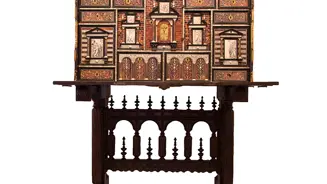
Cabinet
- Spain (?), 17th century
- Wood, ivory, iron, tortoiseshell and velvet
- Inv. No. PNS3073
Here, the references to classical antiquity coexist with the expression of an in-depth knowledge of the Bible. On this ivory and tortoiseshell inlay writing desk, you can see the Annunciation, the Tower of Babel, the meeting of St. Elisabeth and St. Joachim, and a scene with an archangel.
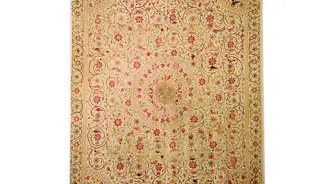
Coverlet
- India, 18th-19th century
- Linen, silk and cotton
- Inv. No. PNS5757
Splendid objects required first-class materials and craft skills of the highest order. The silk of Indian embroidered bedspreads offered the perfect medium for creating rich compositions of animals and flowers, which would certainly have caught the eye of the beholder.
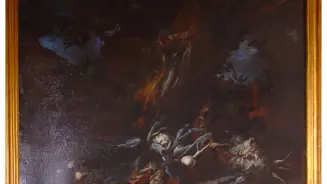
Still Life
- Pietro Pablo Bronzi
- Italy, 1660
- Oil on canvas
- Inv. No. PNS3595
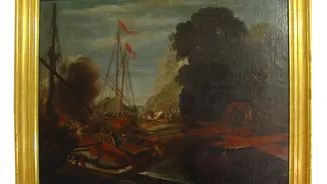
Boats in Shipyard
- Italy (?), 1st half 18th century
- Oil on canvas
- Inv. No. PNS3598
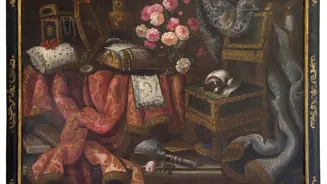
Still Life
- Tibaldi, Antonio (attrib.)
- Italy, 2nd half 17th century
- Oil on canvas
- Inv. No. PNS3600
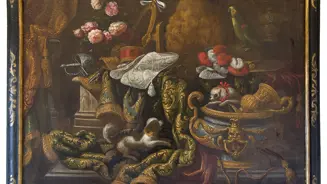
Still Life
- Tibaldi, Antonio
- Italy, 2nd half 17th century
- Oil on canvas
- Inv. No. PNS3601
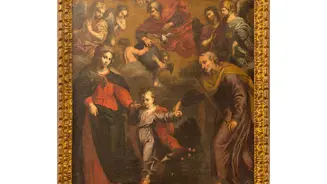
Holy Family
- Bento Coelho da Silveira
- Portugal, late 17th century
- Oil on canvas
- Inv. No. PNS3603
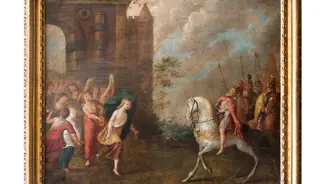
Jephthah returning victorious from battle is greeted by his daughter
-
Dutch School (?), Flemish School (?), 17-18th century
- Oil on copper
- Inv. No. PNS3602
Representation of an episode in the story of Jephthah, namely the moment when the Gileadite leader is greeted by his only daughter after the military victory over the Ammonites. Jephthah, before the battle, had made a vow to Jehovah: if he returned victorious from battle, the first person to leave his house in Mizpah Gilead to meet him would be offered as a sacrifice to the Lord. The story of Jephthah's vow is found in the Hebrew Bible (Old Testament) at Judges 11:29-40.
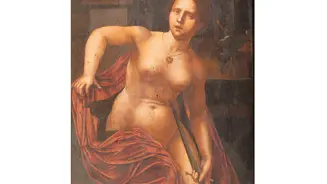
Death of Lucretia
- Italy, 1st half 16th century
- Oil on wood
- Inv. No. PNS3604
The history of antiquity was one of the main subjects in the education of Renaissance nobles and offered a way to learn about the virtue of good government. In 510 BC, after being raped by Tarquinio, son of the king of the Romans, Lucretia commits suicide. The episode precipitated a revolt that led to the fall of the monarchy and the establishment of the Republic of Rome.
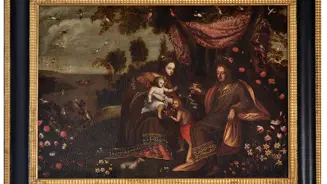
Holy Family with St John the Baptist as a Child
- Portugal, 2nd half 17th century
- Oil on canvas
- Inv. No. PNS3608
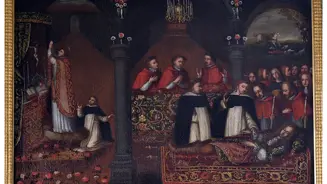
Death of Prince Afonso
- Portugal, 2nd half 17th century
- Oil on canvas
- Inv. No. PNS3609
This painting depicts the death of Prince Afonso in 1491. He was the only son of King João II (1455-1495) and heir apparent to the throne. This tragic event forced the king to select a new heir. He chose his cousin, who would become King Manuel I (1469-1521).
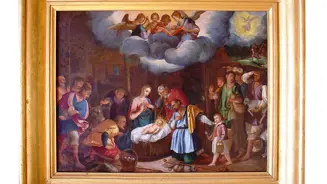
The Nativity
- Antwerp, late-16th century
- Oil on wood
- Inv. No. PNS3610
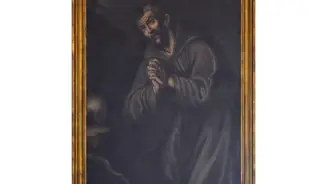
Saint Francis of Assisi
- Spain, mid-17th century
- Oil on canvas
- Inv. No. PNS3629
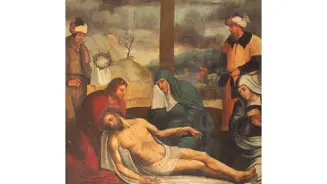
Christ descending from the Cross
- Master from Arruda dos Vinhos (attrib.)
- Portugal, mid-16th century
- Oil on wood
- Inv. No. PNS3633
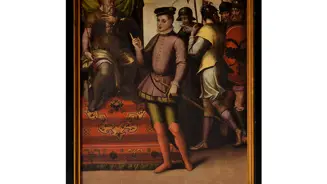
Saint Sebastian’s Trial
- Portugal, last third 16th century
- Oil on canvas
- Inv. No. PNS3634
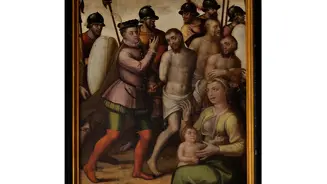
Saint Sebastian releasing Christian captives
- Portugal, last third 16th century
- Oil on canvas
- Inv. No. PNS3635
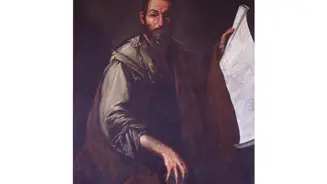
Philosopher
- José de Ribera, Workshop
- Spain, c.1630
- Oil on canvas
- Inv. No. PNS3636
There are several versions of this painting, which reflects the interest in representing those thinkers of classical antiquity (Greece and Rome) whose works inspired and spurred European philosophy in the sixteenth and seventeenth centuries.
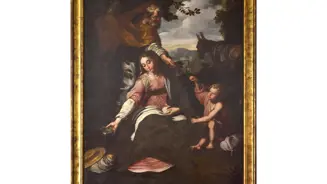
Rest on the flight into Egypt
- Baltazar Gomes Figueira (attrib.)
- Portugal, 17th century
- Oil on canvas
- Inv. No. PNS3637
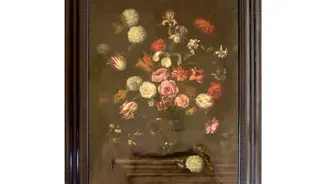
Still Life
- Flanders (?), 17th century
- Oil on copper
- Inv. No. PNS3638
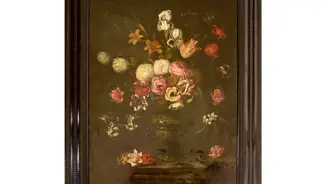
Still Life
- Flanders (?), 17th century
- Oil on copper
- Inv. No. PNS3640
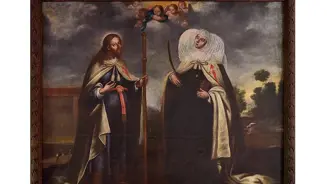
St James the Greater and St Claire
- Portugal, 1st half 17th century
- Oil on canvas
- Inv. No. PNS3639
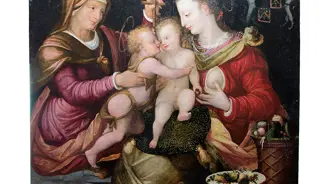
The Virgin, the Child, St Elisabeth and St John the Baptist as a Child
- North of Europe (?)
- 2nd half 16th century
- Oil on wood
- Inv. No. PNS3642
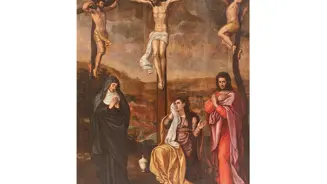
Calvary
- Flemish school, mid-16th century
- Oil on wood
- Inv. No. PNS3643
This sixteenth century Flemish painting depicts the Calvary and the crucifixion of Jesus Christ. Christ is at the centre of the composition, flanked by the Virgin Mary and Mary Magdalene. It came from Ajuda Palace to this palace’s collection in 1940.
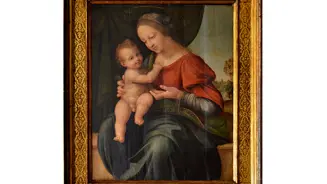
Virgin and Child
- Cesare da Sesto (attrib.)
- Italy, late 15th century
- Oil on wood
- Inv. No. PNS6176
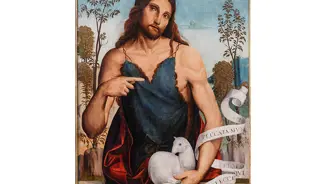
St John the Baptist
- Francia, Francesco (attrib.)
- Italy, 1st quarter 16th century
- Tempera (?) on cloth and wood
- Inv. No. PNS6177
St. John the Baptist is shown wearing a garment of camel’s hair with a lamb by his side. The lamb signifies the moment when he baptised and recognised Jesus as the son of God, declaring: “Here is the Lamb of God.” This painting is a copy made in the workshop of the Italian master Francesco Francia in the early 16th century. It has been part of the Palace collection since 2010.
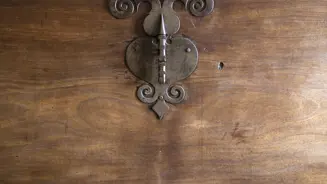
Chest
- Portugal, 18th century
- Brazilian mahogany, rosewood and metal
- Inv. No. PNS2938
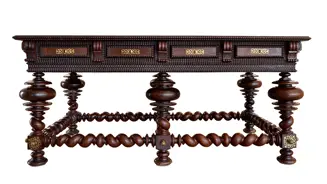
Buffet table
- Portugal, 18th century
- Rosewood and copper
- Inv. No. PNS2948
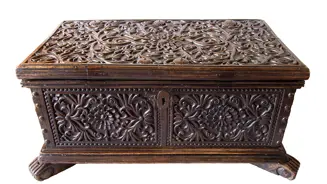
Chest
- India, 17th century
- Teak wood, lacquer and iron
- Inv. No. PNS2963
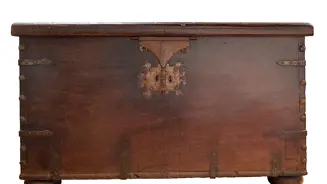
Chest
- India (?), 17th century
- Wood (sucupira?), iron and metal
- Inv. No. PNS2965
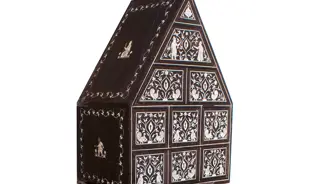
Cabinet
- India, 16th-17th century
- Ebony and ivory
- Inv. No. PNS3069
This small cabinet is an early example of furniture made in Asia for the European market. It was produced in the late 16th or early 17th century between the region of Gujarat, in northwest India, and Sindh, in Pakistan. The decoration shows human figures dressed in distinctive clothing relating to European and South Asian practices. By feat of illusion, its six drawers look like nine. The top opens via a secret mechanism at the back.
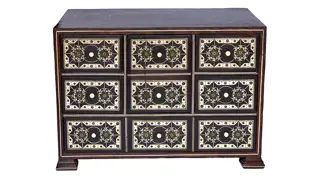
Coffer
- India (?), 19th century
- Wood (teak and ebony), ivory and metal
- Inv. No. PNS3069B
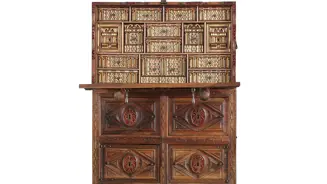
Cabinet
- Spain, 16th-17th century
- Walnut, velvet, iron
- Inv. No. PNS3076
Writing desks were the main pieces of furniture in the noble houses of the sixteenth and seventeenth centuries. They held all kinds of precious items, such as jewellery or money, but also contracts, deeds and other important papers. The power of the noble house was also based on the rights and properties to which these papers attested. This desk is a fine example of the sophisticated inlay technique typical of Granada.
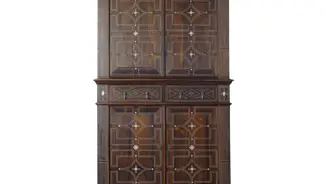
Cupboard
- Portugal, 19th century
- Rosewood, ivory and gilded metal
- Inv. No. PNS3055
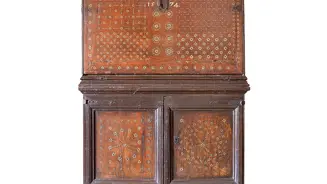
Cabinet
- Italy/Spain (?), 1574
- Walnut, oak, boar bone and iron
- Inv. No. PNS6178
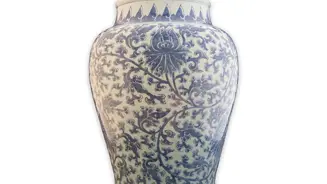
Pot
- China
- Qing Dynasty - Kangxi reign (1662-1722)
- Porcelain
- Inv. No. PNS01
Chinese porcelain began to arrive in Portugal in large quantities from the early sixteenth century onwards. It became popular because it offered a more convenient alternative to the silver services then in use. In the seventeenth century, some of the pieces became display items, as is the case with this example.
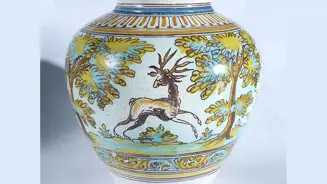
Pot
- Spain, Talavera (?), 16-17th century
- Earthenware
- Inv. No. PNS26
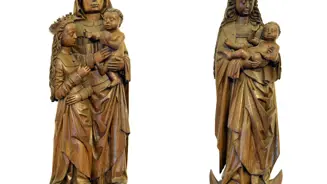
Holy Mothers and Virgin and Child
- Holy Mothers (left) and Virgin and Child (right)
- Germany, 15th-16th century
- Oak
- Inv. No. PNS3511 and PNS3512
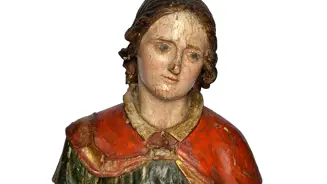
Bust of a young man
- Florence, 16th century
- Polychromatic wood
- Inv. No. PNS6185
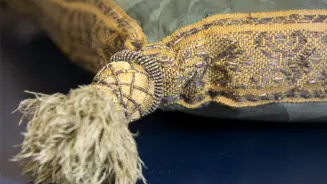
Pillow
- Portugal (?), 18th-19th century
- Silk, linen, burlap, gold thread and wood
- Inv. No. PNS5770
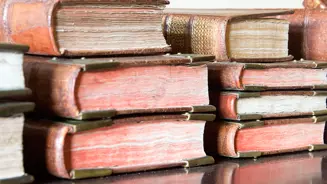
Books
- Psalter - Portugal, 18th century; leather, wood, metal and linen; Inv. No. PNS3651
- Antiphonary - Portugal (?), 18th century; leather, wood, metal and linen; Inv. No. PNS3652
- Missal - Portugal (?), 18th century; leather, wood, metal and linen; Inv. No. PNS3654
A mastery of Latin, the classical authors and the main canonical works formed part of every noble’s education until the eighteenth century. A noble’s power also depended on their virtue and eloquence.


